Cornish Game Hen Soup — To Sooth and Satisfy
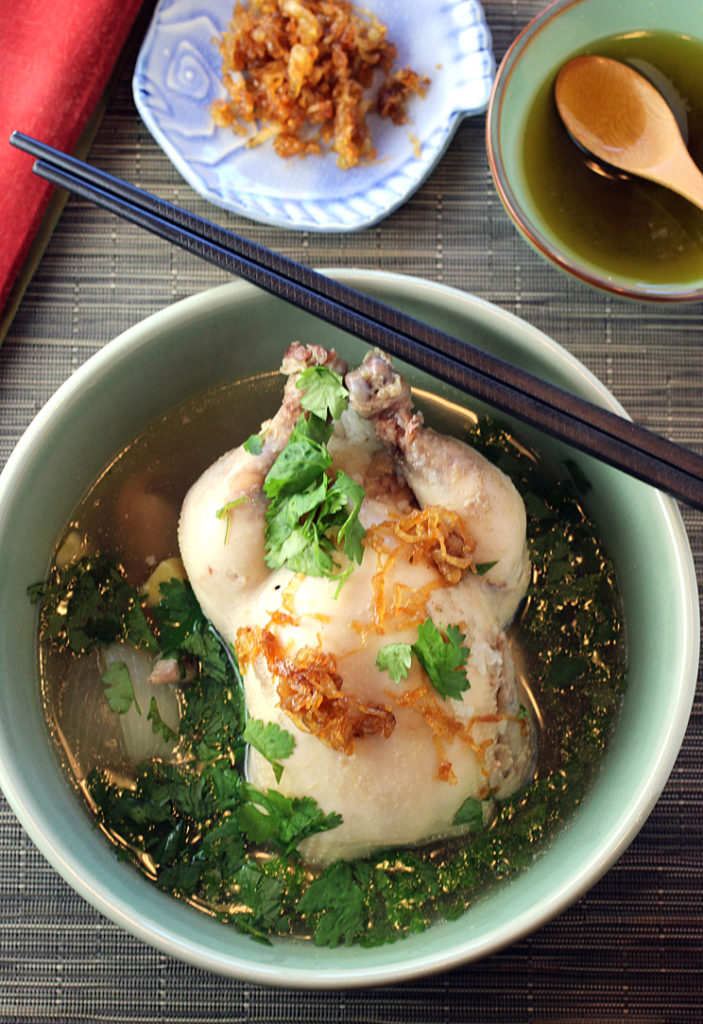
Our fickle spring weather may be warm one day, and chilly the next. But this is one recipe to keep handy whenever you need a restorative slurp that’s like a great big hug in a bowl.
“Cornish Game Hen Soup” is all that, and straightforward to make, too.
It’s from the new “Korean American” (Clarkson Potter), of which I received a review copy, by the gifted New York Times staff food writer Eric Kim.
In this wonderful cookbook, Kim tells the story of being born to Korean immigrant parents trying to make a new life in an Atlanta suburb, where there was no Korean grocery to be found. So, his mother, whom he frustratingly says never measures anything nor ever gives out an entire recipe willingly, adapted and made do. The Korean home-cooking he grew up on was not necessarily completely traditional food, but a delicious amalgamation of cultures and countries flavored with unmistakable can-do spirit.
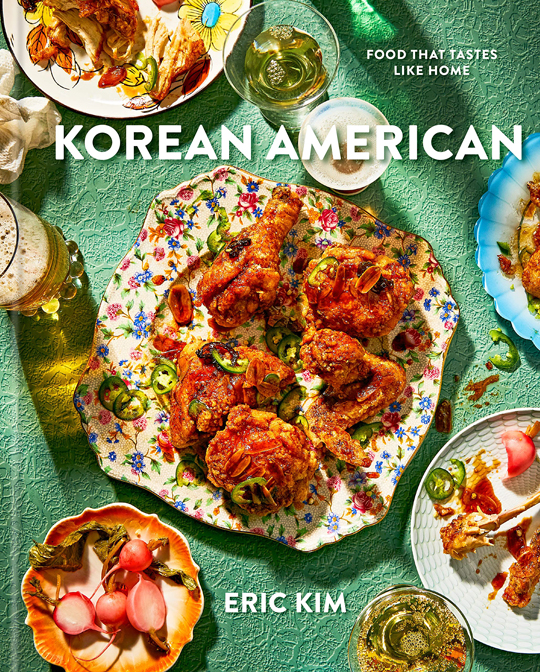
With bright technicolor photos, the book brings to life his bold, playful, and comforting dishes such as “Creamy Butatini with Roasted Seaweed,” “Meatloaf-Glazed Kalbi with Gamja Salad,” “Kimchi Sandwiches,” and “No-Churn Ice Cream with Dalgona Butterscotch Sauce.”
As Kim rightly points out, Cornish game hens are often the forgotten poultry, tucked away unceremoniously in some back corner of a supermarket’s freezer.
This recipe, however, puts the spotlight squarely on them.
It’s based on Korean samgyetang, a soup typically made with a small, young chicken stuffed with rice and boiled in a broth with jujubes (red dates) and ginseng. Kim simplifies that, subbing in other everyday aromatics instead.
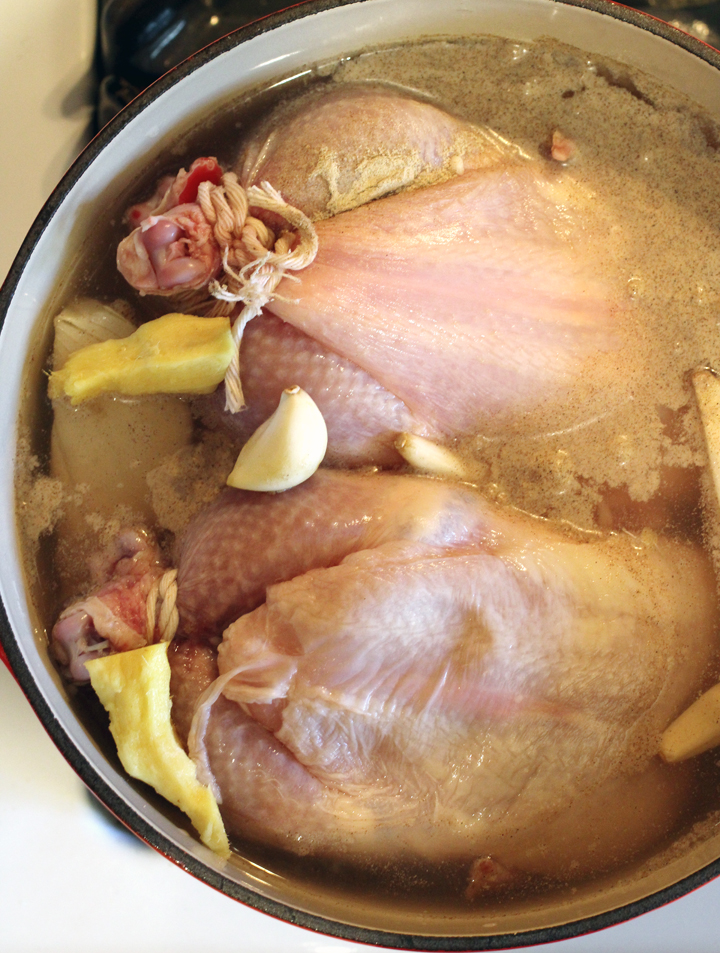
The two whole Cornish game hens get stuffed with whole garlic cloves and uncooked glutinous rice grains, then simmered in some water fortified with onion, ginger, white pepper, and more garlic cloves.
Yes, this recipe uses 17 garlic cloves in total. Kim advises to buy ready-to-use cloves in jars to make the peeling easier. Or to just go ahead and smash them with the side of a knife to remove their skins. Another trick I learned long ago to keep the cloves whole is to pile them into a small metal mixing bowl, then cover it with another metal mixing bowl and shake vigorously. The shaking will loosen the papery skins, but leave the cloves intact.
As the hens simmer, make the garnishes. Gently fry thinly sliced shallots in a generous amount of oil until crisp. Remove them from the oil to drain on a paper towel, but save the oil and season it with salt and more white pepper.
After an hour, the hens should be cooked through. You may want to remove one from the liquid and stick a spoon in its cavity to check that the rice filling is cooked through. Admittedly, mine was not, even after 75 minutes of simmering. If that’s the case, you can return the hen to the pot, cover, and continue cooking further until the rice is done. Or if you’ve got a husband getting hangary like mine, the other option is to remove the rice from both hens, place in a microwavable bowl, cover loosely with a paper towel, and nuke for about 2 to 3 minutes. I added that tip to the recipe below.
You can then serve the rice separately alongside, stuff it back into the hens or just divide it up between two big bowls along with the hens and the broth.
Sprinkle the crisp shallots over everything, and go at it with spoon and fork, drizzling on some of the seasoned oil along the way.
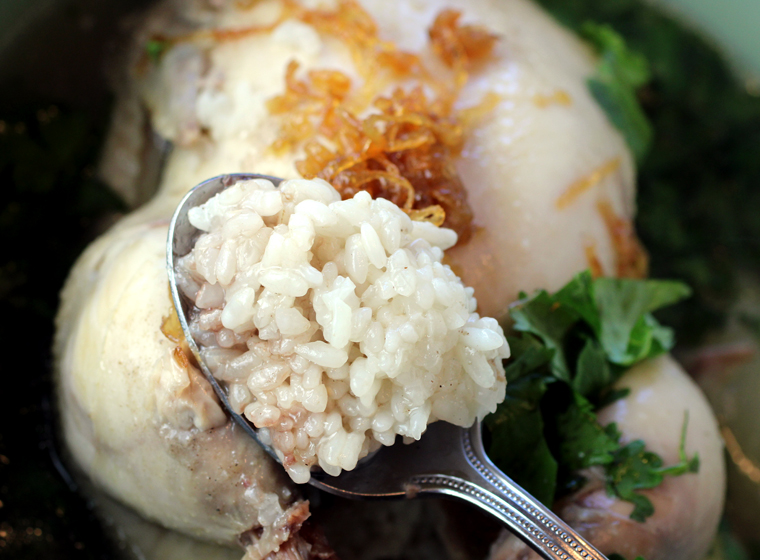
This dish is reminiscent of Hainan chicken, a classic beloved in Southern China, Singapore, Malaysia and Indonesia, in which a whole chicken is poached, and served with dipping sauces, and rice cooked with the broth.
The Cornish game hens take on that same characteristic with moist, fall-apart-tender flesh and soft skin. The broth is at once delicate tasting yet also potent with the bite of white pepper. The rice is sticky, starchy and chewy. The shallots add texture plus a mild, caramelized onion flavor, while the oil gives a little fatty richness to this austere dish.
Kim says that this recipe serves two, with each person getting a whole Cornish game hen, which amounts to quite a lot. So, don’t be surprised if you end up with leftovers, which make for a nice lunch the next day.
It’s a dish that keeps on nourishing.
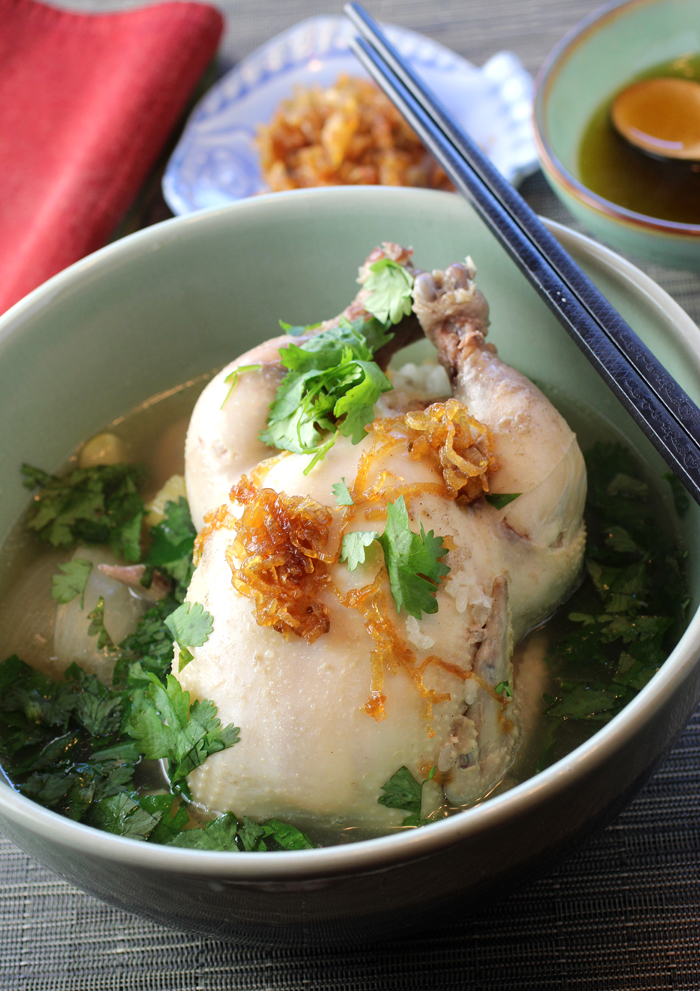
Cornish Game Hen Soup with Fried-Shallot Oil
(Serves 2 very generously)
3/4 cup glutinous rice (aka sweet rice), or any other short-grain white rice
2 Cornish game hens (1 to 1 1/2 pounds each), any giblets removed and discarded
17 large garlic cloves, peeled (see Note)
Kosher salt and ground white pepper
4-inch piece fresh ginger, thickly sliced
1/2 large yellow onion, halved
2 medium shallots, thinly sliced
1/2 cup olive oil
Fresh cilantro leaves plus tender stems for serving
Place the rice in a sieve and run it under the tap for a few seconds to rinse off some of the excess starch. Transfer to a small bowl and cover with water. Let soak for 10 minutes, then drain the rice in the sieve.
Set the Cornish game hens on a cutting board and insert 5 garlic cloves into each bird’s cavity. Using a spoon, divide the rice evenly between the cavities as well. (You can tie their legs together at this point with kitchen twine, but I tend to just skip this step. I don’t mind a little rice escaping their cavities and thickening the lovely broth.)
Place the stuffed hens, breast-side up in a medium pot or saucepan (they should fit snugly). Sprinkle with 2 teaspoons salt and 1 teaspoon white pepper. Add the remaining 7 garlic cloves, ginger, and onion around the hens and fill the pot with water so the water nearly covers the hens but not completely (it’s actually best that they’re not fully submerged so the white meat can slowly steam in the covered pot while the dark meat braises in the soup and gets effortlessly tender). Bring the pot to a boil over high heat. Cover, reduce the heat to low, and simmer, spooning the hot broth over the breast meat a couple times during cooking, until the chickens are cooked through and super tender, about 1 hour. You know it’s done by jiggling one leg; the meat will be so soft that the bone may fall right out.
Meanwhile, in a small saucepan, bring the shallots and olive oil to a gentle simmer over low heat. Stir occasionally until the shallots start to brown, 20 to 30 minutes. Using a slotted spoon, remove the crispy shallots and transfer to a plate lined with paper towels to drain. Season the oil with a little salt and white pepper and set aside. This will be the dipping sauce for the chicken.
Season the soup with additional salt and white pepper, as needed, then use two forks to transfer each hen to its own soup bowl. At this point, stick a spoon inside each hen and see if the rice is fully cooked. If not, you can either return the chicken to the pot to continue cooking in the broth, covered, for a few more minutes or remove the rice from each hen to a microwavable bowl. Cover the bowl loosely with a piece of paper towel and microwave 2 minutes or so until the rice is cooked through. Then, spoon half the rice into each bowl or back into the cavities of the hens.
Divide the broth between the bowls, top with the fried shallots and fresh cilantro, and serve with the shallot-y dipping sauce.
Note: Seventeen cloves of garlic: That is not a typo, and all of that garlic is absolutely imperative. This dish is yet another reason I recommend buying one of those containers of ready-peeled garlic cloves (a real staple in our Korean American household). But should you be starting from a couple fresh heads, don’t hesitate to smash the cloves with the side of your knife to more easily separate them from their skins.
Adapted from “Korean American” by Eric Kim
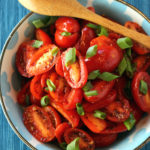
Another Eric Kim Recipe to Savor: Grape Tomato “Quick Kimchi”

I first heard about Qochon from you. I really enjoyed their garlic noodles with vegetables. They seem to be out of business. Do you have any information about where they have gone? Thanks
Hi Allen: Unfortunately, Qochon apparently closed, one of so many that did during the pandemic. I don’t know where the owners are now. So sad to see this gem of a place shutter.